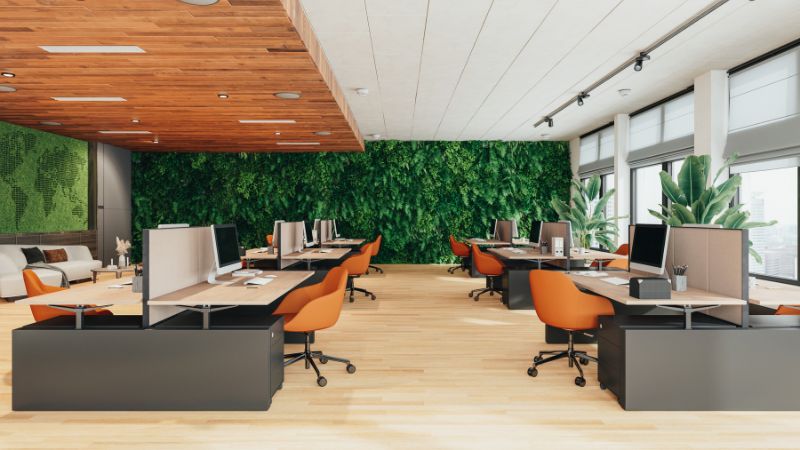Most companies around the globe have taken on a new stakeholder: our planet. As such, workplace sustainability has become a larger focus for many businesses—both small and large. If you’re in need of an eco-friendly workplace overhaul, we’ll explore why sustainability in the workplace is important along with how to help you achieve this with 10 ways you can create it.
Clocking In to Stop Climate Change
In addition to profit, people and the planet are increasingly becoming more important to businesses all around the globe. And this focus on the triple bottom line has never been more crucial. According to a recent McKinsey report, the time to respond to climate risks is now.
Impacts of climate change may only impact specific areas of the world or country, but it’s expected to result in systemic effects that span across all regions—influencing both socioeconomic and financial systems. From employee health to infrastructure damage, no type of business is immune to the various climate risks that are already taking place around the world.
Many societies have begun taking steps towards adapting to climate change, but it’s clear that both the scale and the pace need to increase. This is where workplace sustainability comes in. The green workplace can be defined as: “a workplace that is environmentally sensitive, resource efficient, and socially responsible.” Ultimately, it prioritizes a company’s biggest assets: the planet upon which business relies and the health and wellness of its employees.
While strategies to transform an office or factory into a sustainable workplace will likely require time, effort, and up-front costs, the investment now will likely pay off in the long run in more ways than one.

Benefits of a Green Workplace
In many cases, sustainability can mean cost-savings, increased productivity, increased shareholder value, an improved workplace culture, and more. For example, reducing energy usage, switching to eco-friendly LED light bulbs, and/or installing solar panels can significantly reduce your energy bills. Employees who work for eco-friendly companies also tend to be more motivated, more connected, and 16% more efficient.
This can contribute to recruiting and retention improvements, and your sustainability efforts can also serve as an effective branding and marketing tool. Today’s average shopper is someone who makes decisions based on their values—and around 58% of Americans report that a company’s impact on the environment plays a big role in their purchase decision.
Doing good by using renewable energy, offsetting your carbon emissions, or using compostable/recyclable materials can provide you with an improved brand image and competitive advantage.
10 Workplace Sustainability Ideas
1. Set Sustainable Standards for Suppliers
You can install all the LED bulbs you want and give all of your employees a reusable water bottle, but if you’re not incorporating sustainability into your entire supply chain, you’re missing out on some big impact.
Sustainability can look like: Establishing a Sustainability Code of Conduct that incorporates things like energy and water savings, auditing your suppliers to make sure that they’re employing environmentally friendly practices, working with electricity providers that use renewable energy, or cutting out a supplier completely and taking on part of the supply chain yourself.
PRO TIP: While Nike certainly has a checkered past when it comes to ethical business practices, they have shaped up in recent years and have learned a lot from their mistakes. Check out their latest Sourcing and Manufacturing Standards that allow them to rate their suppliers.
2. Use Biophilic Design in Your Spaces
Biophilic design has become a big deal over the past couple of years, and for good reason. When we model indoor spaces after nature, we’re happier and healthier—and the planet is too.
This can be something simple, like adding plants into your workplace or installing a skylight. It can be much bigger than this, too. Microsoft has some treehouse conference rooms and Amazon’s Spheres building is a botanical garden with more than 40,000 plants!

3. Minimize Electricity Consumption
Just think about the unnecessary usage of lights and machinery in your office. Are lights left on all the time? Are they on during the day, when natural light through the windows would be enough? Do you have a system in place to properly shut down equipment and computers at the end of each work day?
Experiment with different ways to reduce your energy consumption. Put stickers around the building to remind employees to turn off lights when not in use. Or, try installing motion sensors and automatic lights.
PRO TIP: LED bulbs are considered to be some of the most efficient technologies currently available. Switching to these light bulbs can result in a 25% to 30% reduction in energy (and they last 25 times longer). Need some eco-friendly lightbulb recommendations? We’ve got you covered with our article, 5 Great Eco-Friendly Lightbulbs that Don’t Leave Our Planet in the Dark.
4. Adopt Water Conservation Practices
If you have it in your budget, converting to water- and energy-efficient appliances is the way to go. If you don’t have it in your budget, make sure you at least get around to fixing that leaky faucet or follow these easy toilet water reduction steps to transform your toilet(s) into a low-flow model.
5. Make Lunch Breaks and Coffee Breaks More Sustainable
If you have a cafeteria, consider removing low nutrient, junk food options and encouraging healthy (and more sustainable) choices instead. Try substituting a salad bar for pre-packaged chips or only serving vegetarian options on Meatless Mondays.
You can also tackle office food waste by turning it into compost. Try to develop a partnership with a local farm—you may be able to provide your food waste for compost and, in turn, may receive some produce from them.
Do away with any plastic or styrofoam, and instead use real dishes that can be washed. If you have a staff area for coffee, don’t use paper cups and trade in your Keurig coffee maker for one that doesn’t produce as much plastic waste (or at the very least, get a reusable coffee pod for the machine). Even better, you ca invest in organic and fair trade coffee (caffeine addicts, click here to read more about making your coffee habit sustainable).
PRO TIP: Even the government wants to help you minimize food waste! Check out the Food Recovery Challenge for more info.
6. Get Your Employees Involved
Chances are that you already have at least one eco-enthusiast in your workforce, so get them involved! Give them an hour or two every month to do an environmental audit or conduct educational lessons with your staff.
Even better, start a sustainability team and establish monthly green challenges. You can have everyone record how often they ride their bike to work or eat meatless meals and then supply a desk plant or a zero-waste household item for the winner!
7. Unplug Your Devices
What if you’re working from home?
Phantom energy, interestingly also known as vampire power, is a term used to describe the draw of power that electronics consume even when they’re not being actively used. You may not be listening to your stereo, watching TV, or using your laptop but the “standby” power mode is still racking up a pretty significant portion of your energy bill (around 23%!).
So, unplug, unplug, and unplug some more.
8. Adjust Your Thermostat
It may sound impossible—or it may sound too good to be true—but making just a 2 degree adjustment on your office (and home) thermostat can save 2,000 pounds of CO2 emissions per year! Yes, it may mean that you need to wear an extra layer or have a glass of ice water handy, but it’s worth it!
Plus, studies show that if you regularly expose yourself to cold conditions (anything that makes you shiver), you’ll acclimatize to colder temperatures in just one week.
9. Decrease the Brightness on Your Computer Monitor
Reducing the brightness of your computer monitor can save up to 20% on energy use as well as save your company money ($82 per year)! Also, make sure to enable the energy savings mode.
10. Buy Used Supplies
If you’re going to be working from home and that spare bedroom has to become a combination classroom and/or office, you’ll need to refurnish it. Instead of looking for new furniture and supplies, why not consider something used instead?
Antique shops, thrift stores, and online sites like Craigslist and Facebook marketplace are all great options for finding second-hand office furniture and equipment. Not only will you help to reduce landfill waste, but you’ll also save a lot of money in the process.
Get Creative!
Workplace sustainability has never been easier—the ideas are endless! Even with more people working from home these days, there’s an abundance of things you can do to minimize your environmental impact like taking less showers, less takeout coffees/lunch, etc. regardless of whether you’re in the office or working from home.
If you’ve been making sustainability changes at your job, we’d love to hear your tips! Let us know in the comments what you would add.
This post was originally published on January 21, 2021 and updated on January 12, 2024.














